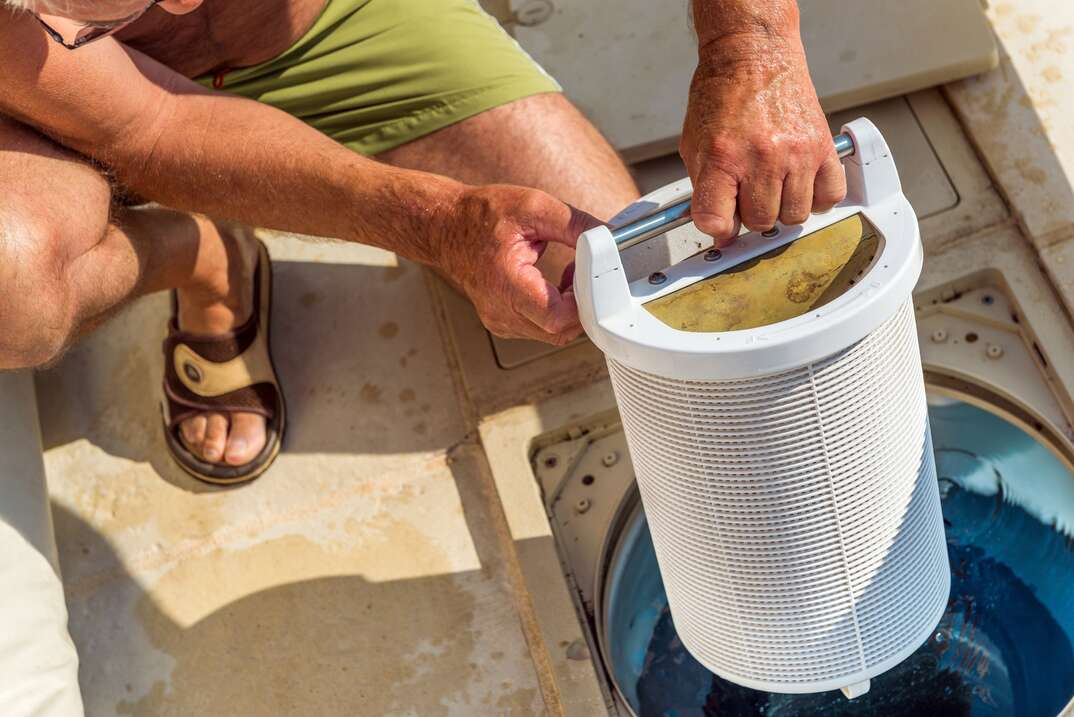- AppliancesElectriciansHVACLandscapingLocksmithPest ControlPlumbingRenovationRoofingT V RepairAll Home Improvement
- Car AccidentClass ActionCorporate LawCriminal DefenseDivorce LawEmployment LawFamily LawFinancial LawLegal AidMedical Injury LawyersMedical MalpracticeReal Estate LawWater Fire RestorationAll Legal
- InvestmentRetirementAll Finance
- Animal InsuranceAutoGeneral InsuranceHealth PolicyHome RentersAll Insurance
- DentalHealth SpecialistsAll Medical
- Animal CareVeterinaryAll Pets
- Auto GlassTowingAll Automotive
How to Clean a Pool Filter: 5 Simple Steps

Few images are as iconic of summer as a sparkling backyard pool beckoning in the sun on a warm day. But that idyllic image can quickly get tainted when the water in your oasis starts to turn cloudy.
Read More Home Improvement Articles
Fortunately, all that usually means is that it's time to give your filter a quick clean. Here's how to get it done so that you can get back to enjoying your pool instead of worrying about it.
How Does a Pool Filter Work?
Your pool filter is a compartment through which all of the water in your pool circulates. Pool filters come in three basic styles: sand, diatomaceous earth and cartridge. In the first two types of filters, the water passes through a granular material (either sand or diatomaceous earth), where debris is trapped, and the cleaned water flows back into the pool.
Here we will focus on the third kind of filter: the cartridge filter. In these systems, the water passes into a compartment into which a standalone filter is inserted. These filters come in a variety of shapes and sizes and, while they can look like they are made from paper, they are usually constructed of spun polyester, making them quite durable. The typical lifespan for a standard-sized cartridge is about 12 months, while larger-sized models can last up to three years.
Where Is My Pool Filter?
Your filter will be found inside a PVC housing somewhere on the outside of your pool. It will have a line running into it that delivers dirty water from the pool to the filter, and a return line that brings the water back into the pool once the filter has trapped any debris it contains. The filter will also have an electrical supply line running to it, which powers the pump controlling the flow of water.
How Often Should I Clean My Pool Filter?
A general guide is to clean your filter at least once a week during swimming season, and certainly whenever the water begins to appear cloudy. But a more precise approach is to look at the PSI gauge found on top of the filter housing and take note of the number the arrow points at during regular operation, when you know the filter is clean. When that gauge shows a PSI that's 10 points higher than normal, it's time to give it a clean.
More Related Articles:
- How Much Does a Home Inspection Cost?
- 4 Tips for Hiring a General Contractor for Your Next Remodeling Project
- Should You Hire a Contractor or a Handyman?
- 5 Things to Look For When You're Hiring an Electrician
- What to Look for When Hiring an Exterminator
How Do I Clean a Pool Filter?
Step 1: Safety First
First, be sure that the power to your pool pump assembly is off. This might mean switching it off at a timer, or simply unplugging it. You never want to work on a pool filter that has power running to it.
Step 2: Remove the Cartridge Housing
Next, following your pool pump manufacturer's instructions, remove the top of the cartridge housing. This usually involves releasing a clamp and rotating the top of the housing.
Step 3: Remove the Filter
Remove the filter (or filters if you have multiple cartridges) and place them upright on a clean surface like a wood deck, concrete patio, or asphalt driveway. You don't want to clean your filter on grass or dirt as it will cause debris to shoot up into the filter.
Step 4: Spray It Down
Place a high-pressure nozzle on your garden hose and, working from top to bottom, spray your filter at a close range, removing any debris or buildup on and between the fins of the cartridge. If you'd prefer to save water, you can also do a first pass using a high-pressure air gun, but you'll still likely want to give the filter a good rinse with the hose when you are done. Specially made hose attachments that split the stream into finer sprays can also be a help here by allowing the water to reach in between the filter's pleats.
Step 5: Put Everything Back
Once the filter looks clean and clear of gunk, put it back in the housing, tighten everything up and restore the power. You're all set for another week of cool, clear, pool water!
Do I Need to Deep-Clean My Pool Filter?
Sometimes your filter might not respond to cleaning with the jet of water from your hose, as oils from sunscreen and skin can begin to adhere and clog it. If that's the case, you can spray on a commercial cartridge cleaner first and let it soak in according to the package directions. Then, spray it off with the hose. A light scrubbing with a soft brush can also help, but use this method sparingly, as it can shorten the life of the filter.
Elocal Editorial Content is for educational and entertainment purposes only. Editorial Content should not be used as a substitute for advice from a licensed professional in your state reviewing your issue. Systems, equipment, issues and circumstances vary. Follow the manufacturer's safety precautions. The opinions, beliefs and viewpoints expressed by the eLocal Editorial Team and other third-party content providers do not necessarily reflect the opinions, beliefs and viewpoints of eLocal or its affiliate companies. Use of the Blog is subject to the
Website Terms and Conditions.The eLocal Editorial Team operates independently of eLocal USA's marketing and sales decisions.



